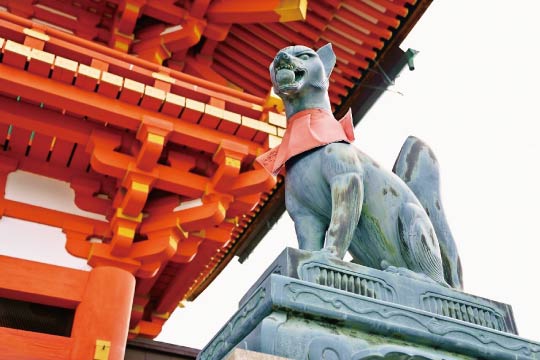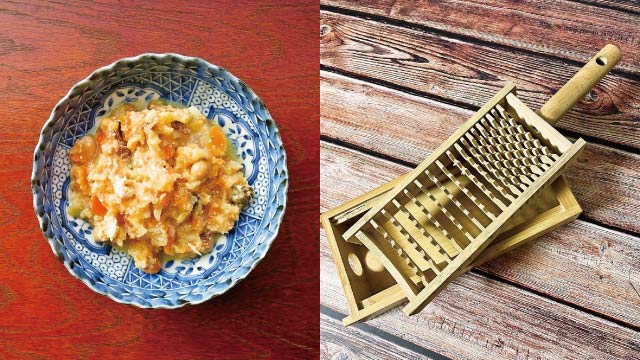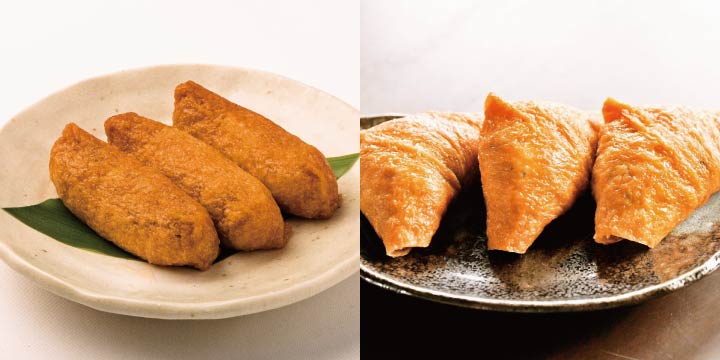News & Blogs
Inari deity enshrined on the day of horse (初午, hatsu-uma) about 1,300 years ago.
Foxes and Torii gates are iconic symbols of the Inari shrines.
Festive food for 'Hatsu-uma' day, Inari sushi (sushi pocket).
Let's make Inari sushi using TREHA®!
In this blog, we touch on diverse topics about Japanese food cultures, practices together with the culinary secret, TREHA®, and its important role in the Japanese food industry. We hope our blog helps you obtain in-depth knowledge of the secrets and science behind Japanese cuisine, shared from our kitchen, to yours.
What is Hatsu-Uma (初午)?
Approximately 30,000 Inari Shrines (稲荷神社) all over Japan celebrate the traditional “Hatsu-Uma” day, the first "horse day" of February in the lunar calendar. The festival is based on the legend that the enshrined deity descended to Fushimi Inari Taisha in Kyoto on the first horse day of February in 711 AD. Fushimi Inari Taisha in Kyoto is the main shrine of many Inari shrines across Japan. In 2023, February 5th is the day of Hatsu-Uma.
The Hatsu-Uma Festival in February uniquely developed from the integration of Inari, identified as the god of agriculture and harvest, and a folk belief in Yama-no-kami, a deity in the mountain forests. Yama-no-kami has been believed to descend in springs as a guardian of cultivation and return to the mountain forests in falls. Thus, the Hatsu-Uma Festival is meant to welcome Yama-no-kami.

Symbols of Inari Shrine: Fox and the crimson Torii gate (Shinto shrine archway)
It is common to find foxes in the images of Inari Shine. Some Japanese even think that the fox is the Inari deity, but this is not true. The foxes at Inari shrines are the deity’s familiars and messengers. Since ancient times, foxes have been considered sacred animals in Japan. They show up in the field when farming season starts in early spring, and stay active, getting rid of pest rodents harmful to the crops until the harvesting season is over. They return to the mountains in the fall. Foxes’ presence in the field overlaps with Yama-no-kami, the mountain spirit.
When a fox is portrayed as a messenger of a deity in Noh and Kagura dance performances, the actor playing a fox wears a white fox mask, defining the role of an invisible mystical, spiritual being apart from wild foxes. Similarly, the sacred animal statue at the Inari shrine presents itself with a red necktie and holy item in its mouth, such as a bundle of rice, mantra scroll, key, or ball made out of gemstone, which respectively symbolizes harvest, wisdom, a clue to make wishes come true, and the deity’s spiritual power.
In addition, multiple red Torii gates are distinct features of Inari Shrines. Many Inari shrines commonly feature innumerable red Torii gates. Red shades have long been considered the color of fire, the sun, and life among the Japanese. In addition, as mentioned in our previous articles, red is believed to have the power to ward off evil spirits. At Inari Shrines, which worship the deity of agriculture, the Torii gates are red because the color is thought to bring sunlight and warmth necessary for rice cultivation. Rows of red gates straddled over the path to the shrine are donors’ offerings to make their wishes come true or tokens of gratitude for achieving their goals after visiting the shrine. This custom became widespread after the Edo period (1603-1868).

What is festive food for “Hatsu-Uma” day?
The most popular dish eaten on the feast day of the Inari God is Inari Sushi, a.k.a. sushi pockets in the US. This uniquely shaped sushi, pronounced “inarizushi,” is seasoned fried tofu pockets stuffed with sushi rice. Fried tofu (abura-age) is considered fox’s favorite food. So why do foxes like fried tofu? There are many theories about this plant-based food; one is based on the custom of offering deep-fried rats to please foxes as they hunt rats, which are destructive pests for crops. However, due to the influence of Buddhism, which prohibited killing animals, fried tofu became an alternative to deep-fried rats.
In a similar fashion to tempura in the previous article, the shape of Inari sushi differs between the West and the East of Japan. In the West, Inari sushi is usually made in the form of a rice bale, but in the West, it is typically triangular, named after the ears of a fox.
The Inari deity has also been worshipped by silkworm farmers, whose numbers increased in the late 19th century. Since rats are the natural enemy of silkworms, their hunters were greatly appreciated. In areas such as Toyama, Gunma, and Gifu prefectures, where silkworm farming is thriving, Dango dumplings made to resemble the shape of cocoons (Hatsu-Uma dango) are offered in the hopes of high production. The ingredients for Dango dumplings vary depending on the region, such as Joshinko (high-quality non-glutinous rice flour) or a mixture of glutinous rice flour, wheat flour, and buckwheat flour.
Another dish for the Hatsu-Uma day of the year is “Shimotsukare,” of which ingredients are salmon head, grated radish, carrots, deep-fried tofu, soybeans, and sake lees. This traditional stewed dish is a local specialty in northern Kanto, mainly in Tochigi Prefecture. According to the oral tradition, consuming Shimotukare from seven families would repel sickness throughout the year. Because of it, people share the stew with neighboring families. The grater used for grated daikon radish for this Shimotsukare is called an "Oni Oroshi" (see photo below). It is made of bamboo, and the blade is more coarse and jagged than a standard grater, resembling a demon's teeth.

Let's make Inari sushi with TREHA®!
After learning about the history of the relationship between the Inari deity and fried tofu, you may be interested in making Inari Sushi. With TREHA®, sushi rice remains moist and palatable for an extended time.
Sunday, February 5, 2023, is the first horse day of the year. Why don’t you try making your Inari sushi in your favorite shape?
Ingredients (for 4-5 servings):
- 20 deep-fried tofu pockets
Broth for simmering fried tofu pockets: (A)
(A) 400cc (1 ⅔ cups) dashi soup stock*
(A) 7 tablespoons sugar
(A) 4 tablespoons soy sauce
* Click here to learn how to prepare delicious dashi stock.
Cooked rice: (B)
(B) 3 cups (=450g=1lb) uncooked rice
(B) 600ml (2 ½ cups) water
(B) 1 tablespoon TREHA®
(B) 5cm square (2-inch square) Kombu kelp
Sweetened sushi vinegar: (C)
(C) 100cc (3 ½ fl. oz.) vinegar
(C) 3 tablespoons sugar
(C) 2 teaspoons salt
*1 tablespoon of TREHA® = about 10g
*1 teaspoon of TREHA® = about 3g
Preparation:
- Add water and TREHA® after washing and rinsing rice. Gently swirl the rice in water to dissolve TREHA® and place the Kombu kelp square before cooking.
- Make the vinegar mixture.
Directions:
1. Pour the vinegar over the cooked rice when it is still hot and hold it into the rice. Use a fan to cool down the rice to obtain a glazed, shiny surface.
2. Place the fried bean pockets in a colander. Pour boiling water over to boil them lightly to remove excess oil.
3. In a pot, combine all broth ingredients, add the drained deep-fried tofu, and simmer until the soup is absorbed.
4. Fill the fried bean pockets with sushi rice and shape them into Inari sushi.

Did you find this blog interesting?
Please share it with your friends in the food service industry.
We regularly update the blog about the food culture of Japan, where TREHA® was discovered for culinary applications.
Click here and send us a message to subscribe.
Or hit us up on Instagram @trehalose_sensei!
You might also be interested in:
Recipe for Assorted Sushi
Exclusive interview with Chef Meguro, the authentic Edomae sushi master in Tokyo
Exclusive interview with Chef Andy Matsuda of Sushi Chef Institute in Torrance, California: 1 of 3
Exclusive interview with Chef Andy Matsuda of Sushi Chef Institute in Torrance, California: 2 of 3
Exclusive interview with Chef Andy Matsuda of Sushi Chef Institute in Torrance, California: 3 of 3
Japanese traditional food series 2: Chitose Ame, candy for healthy longevity (千歳飴)
Japanese traditional food series 3: Yuzu (柚子) and the winter solstice
Japanese traditional food series 4: Noodles on New Year's Eve (年越しそば)
Japanese traditional food series 5: Japanese traditional New Year’s dishes, Osechi-ryori (おせち料理)
Japanese traditional food series 6: Another traditional food for New Year’s celebration, mochi (餅)


